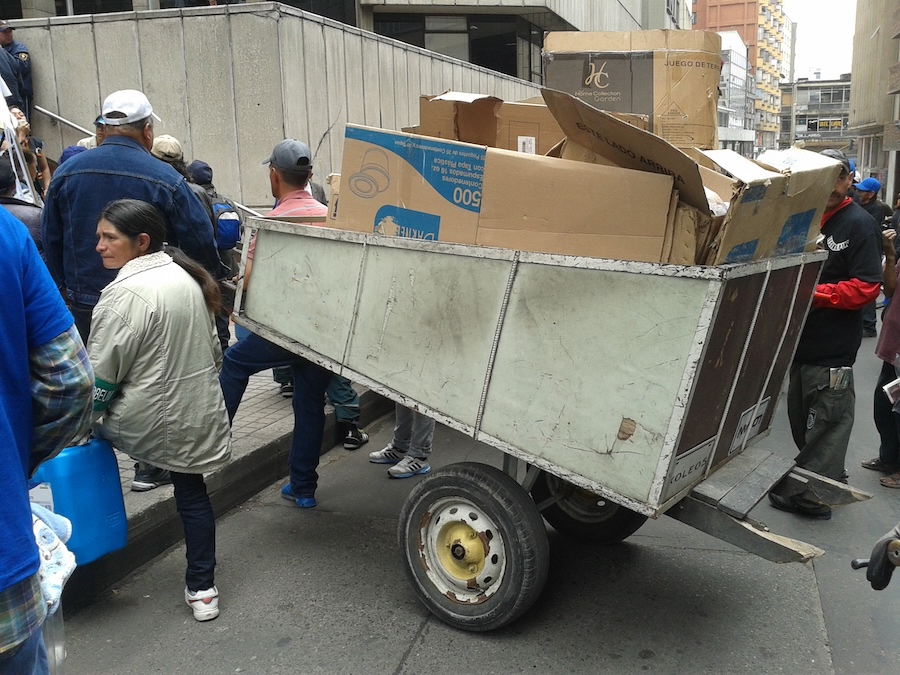Waste Pickers in Colombia: Organization, Rights and Digitization

In Colombia, waste pickers have transformed their social and professional status, evolving from being seen as “disposable people” to being recognized as providers of public recycling services. This transformation was achieved through two key strategies: organizing into cooperatives and associations and advocating for their rights. However, the co-design and implementation of digital tools also played a significant role in achieving this recognition. This article explores how and why this process unfolded.
The case of Colombian waste pickers offers critical insights into the sector globally, especially regarding the role of digitization in empowering informal workers when guided by their collective interests and adopted by the workers themselves.
Background
Waste pickers collect recyclable materials discarded by society, often retrieving them from trash bags or dumpsites, and reintegrate them into the recycling value chain, earning their livelihoods in the process. Recycling has become a vital source of income for millions worldwide; the International Labour Organization (ILO) estimates that 24 million people globally depend on recycling, with 20 million working informally. In Colombia, over 60,000 families currently rely on this activity.
Historically, the waste-picking sector in Colombia has absorbed individuals unable to access formal employment, including the unemployed, internally displaced persons from the armed conflict, external migrants, and other vulnerable populations.
Until the mid-1980s, waste pickers primarily worked in open dumpsites. However, as waste disposal technologies advanced, many dumpsites were closed, forcing waste pickers to shift to collecting materials from garbage bags on the streets. This transition created fierce competition for recyclable materials and exposed waste pickers to harsh working conditions, societal discrimination, and policies that criminalized their work.
Organizing for Rights
In response to these challenges, waste pickers began organizing to defend their rights, improve working conditions, and increase income. With support from non-governmental organizations and Colombia’s National Department of Cooperatives, dozens of waste picker cooperatives and associations were established.
From a productive standpoint, these organizations coordinated efforts to collect, classify, and collectively market recyclable materials, thereby securing better prices through economies of scale. However, their role extended beyond productivity; these organizations became vital in advocating for the human and labor rights of waste pickers.
At the time (early 1990s), Colombia’s waste management policies prioritized privatization, excluding waste pickers and framing them as obstacles. Public policies prohibited their work in urban areas, criminalized access to waste, and banned their traditional means of transport.
The waste pickers’ organizations, led by the Asociación de Recicladores de Bogotá (ARB) and later the Asociación Nacional de Recicladores (ANR), launched numerous legal actions against these discriminatory policies. The Colombian Constitutional Court issued several landmark rulings, recognizing waste pickers as subjects of special state protection and affirming their role in environmental, sanitary, and social solutions to urban waste. These rulings mandated affirmative actions to integrate waste pickers into public waste management and remunerate them as providers of public recycling services.
Consequently, Colombian policies began to support the registration, operation, and remuneration of waste picker organizations as entities responsible for recycling collection, transportation, sorting, and reintegration into the value chain.
Challenges and the Role of Digitization
The initial operational model of waste picker organizations was based on several key components: human-powered vehicles used for material collection, the waste pickers’ expertise in identifying recyclable materials and understanding their value, and recycling warehouses where materials were gathered and processed. Some of these warehouses were managed directly by waste picker organizations.
Building improvements upon this traditional framework posed significant challenges, primarily due to the lack of supportive public policies. Existing policies were designed to promote and consolidate systems for waste collection, transportation, and controlled disposal in landfills, relying on motorized vehicles and prioritizing private companies over associations or cooperatives of informal workers.
In this context, digitization initiatives emerged as critical tools in the development of waste picker organizations and cooperatives as service providers. One of the initial hurdles was creating a system to measure and record the activities of cooperative members during their service provision.
A breakthrough came with the establishment of macro collection routes for recyclable materials, which significantly reduced the burdens faced by waste pickers. Instead of traveling over 10 kilometers between collection and sales points, many organizations introduced motorized routes using trucks to collect the recyclables materials collected by each of the members of the organization in their micro-routes. This innovation reduced the physical strain on waste pickers, minimized time spent in traffic, and lessened their exposure to the hazards of city streets.
To complement this, ARB, with the help of digital experts, developed a real-time registration platform. This platform enabled the detailed recording of the types, quantities, and qualities of recyclable materials collected by members at each collection point. The resulting database became a critical resource, providing robust evidence of public service delivery, material volumes, and each member’s contributions to the collective effort.
This initiative by Bogotá’s waste picker association served as a model, prompting adoption by government entities and other organizations beyond those affiliated with the national association of waste pickers.
While macro routes and real-time material registration platforms represent one operational method, not all waste pickers participating in service provider organizations were included in these routes. Consequently, it became necessary to map and geo-reference all routes undertaken by cooperative members. Initially done manually, these maps evolved with the introduction of digital tools, enabling precise geo-referencing.
Today, several waste picker organizations utilize digital platforms to track their activities, including their geographic presence in cities, the frequency and timing of collections, and the approximate number of households and individuals benefiting from their services.
Although the process has faced challenges, the experience of Colombian waste pickers stands as a pioneering model for organizations worldwide. Their struggle for recognition and remuneration within public waste management frameworks is now a priority for the International Alliance of Waste Pickers.
Learn more about the author: Federico Parra Hinojosa